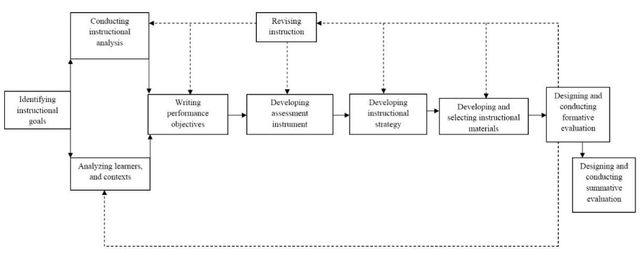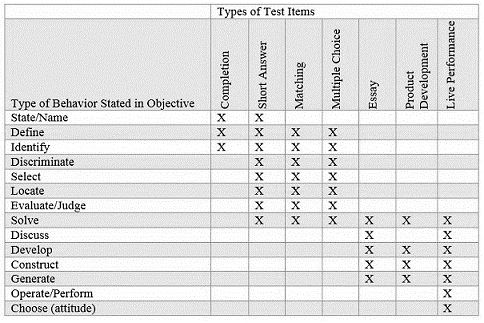
Instructional design is a system of procedures used for developing instruction and training curricula in a consistent and reliable method (Reiser, Reiser, & Dempsey, 2011). While the system of procedures varies, the structure of the design should be both engaging and effective for the learner. This publication applies the best practices of instructional design using the Dick and Carey systems approach. When designing instruction, it is imperative to promote good design for learning. High-quality instructional design that promotes learning possesses the following characteristics (Reiser et al., 2011):
The systems approach by Dick and Carey helps instructional designers develop curricula through a series of nine steps which work together toward a defined instructional goal (Dick, Carey, & Carey, 2005). The Dick and Carey systems approach considers components such as the instructor, learners, materials, instructional activities, delivery system, and the learning and performance environment. Unlike traditional models, the Dick and Carey systems approach is portrayed as a curvilinear flow portrayed with one-way arrows. The curvilinear design portrays an easier way instructional design is practiced and developed (Branch, 1996).

A critical part of the instructional design process is the identification of the instructional goal(s) (Dick et al., 2005). When developing instructional goals, it is best to consult with a subject matter expert. A subject matter expert is the expert in the field for which the curriculum is being designed. A subject matter expert and creator(s) of the curriculum should use a needs assessment to determine the needsof the learners. A needs assessment can be conducted by using an equation from Borich (1979), and can be represented by:
Desired status - Actual status = Need
The desired status is the intended competency level of the learner at the conclusion of the course. The actual status is where the learners are before the course, and the need is the gap between where the learners are presently and where they are to be at the end of instruction. Once a need has been established, goals can then be created. A completed goal statement should include (a) the learners, (b) what the learners will be able to do in the performance context, (c) the performance context in which the skills will be applied, and (d) the tools that will be available to the learners in the performance context (Dick et al., 2005). Revisions for instructional goals will need to be made until each component is included in the instructional goals.
Once instructional goals are established, an instructional analysis can be developed. An instructional analysis is a set of procedures that help identify the skills and knowledge that should be included in instruction. It is important to identify which domain each instructional goal is linked to. Bloom defines the following learning domains of learning outcomes (Bloom, Engelhart, Furst, Hill, & Krathwohl, 1956):
When determining the learners and the context in which the learning will take place, it is important to refer to the target population. The target population is the group of learners that you are trying to reach in instruction (Dick et al., 2005). When considering the target population, it is important to go beyond the context of the learner. When designing curriculum, the designer should consider the following about the target population:
A performance objective is a description of what the learners will be able to do by the end of the unit of instruction (Dick et al., 2005). A performance objective should be written into three parts: (a) conditions, (b) behavior, and (c) criteria.
Examples include the following:
For more information on writing performance objectives, visit EDIS AEC583 (https://edis.ifas.ufl.edu/wc245).
Once performance objectives have been determined and written, it is important to consider the question, "What type of assessment(s) should be used to assess the learners' performance?" Figure 2 indicates the various ways behaviors can be assessed and indicates which types of assessments are appropriate for individual behavioral objectives. It is important to consider the environment in which the assessments will take place, the response time needed by the learners, and the probability of guessing the correct answer.

An instructional strategy is a variety of teaching and learning strategies, which may include group discussions, independent reading, lectures, computer simulations, worksheets, lab work, and much more (Dick et al., 2005). This is generally known as instruction. When considering the instructional strategies for a unit of instructions, there are a few things to consider, such as the goal, the learner motivation and characteristics, the learning objectives, assessment requirements, and the performance context.
The instructional materials contain the content. This can be either written information or facilitated by an instructor that the student will use to achieve the objectives (Dick et al., 2005). This may include any materials that are being incorporated into a lesson. Examples of this may include student workbooks, activity guides, problem scenarios, resource lists, textbooks, or computer simulations. When selecting and developing instructional materials, it is imperative to align the materials to both the objectives in Stage 4 and the assessment instruments in Stage 5.
Formative evaluation is the collection of data and information during instruction that can be used to look at the effectiveness of instruction (Dick et al., 2005). Formative evaluation should be conducted within the instruction, and happening as instruction is taking place. However, formative evaluations may not always take place in non-formal instruction. Formative evaluations can be completed in many ways. Examples may include:
Summative evaluation is a collection of data that looks at the effectiveness of instruction as a whole (Dick et. al., 2005). Summative evaluation measures an entire unit of instruction and multiple performance objectives. When developing the summative evaluation, it is important that the objectives match the summative evaluation. Summative evaluations differ from formative evaluations. The main difference is the purpose for conducting an evaluation. Formative evaluations identify improvements needed during instruction, whereas summative evaluations identify strengths and improvements after instruction.
Mr. Zhao, a fifth-year agriscience teacher, has decided to rework the curriculum he designed as a first-year teacher for his urban agriculture class. Since his curriculum was developed, Mr. Zhao has significantly changed the agriculture industry. He wants to ensure that his students get the most up-to-date knowledge of current urban agricultural practices. As such, Mr. Zhao reached out to 5 industry leaders and invited them to tour his agriculture program and review the existing units of instruction he made. After the tour, Mr. Zhao asked each specialist to offer suggestions on improvements and needed changes that they saw. Mr. Zhao then took the feedback and adapted the seven units he used to teach the class. Part of that process included reviewing state standards and objectives to ensure students met state expectations. He then started working with Mrs. Abimbola, his cooperating teacher. They identified what learning domains each unit emphasized and discussed if and how each could be adapted to increase student comprehension. For example, in the turkey unit, students were given a blueprint and a materials list and instructed to build a turkey tractor. While this did engage the psychomotor and cognitive domains, Mrs. Abimbola and Mr. Zhao felt a tool identification element and a small summative assessment at the end of the unit would help to vary the levels of learning for each student. Mr. Zhao currently only offers this course to high school senior students, but after speaking with the specialists and thinking through his student demographics has decided to open the class up to high school juniors as well. With the new addition of junior students, Mr. Zhao then adapted his previously set performance objectives to include the abilities of the junior students. To identify student learning, Mr. Zhao identified his current assessment measures, including summative tests, quizzes, performance tests, bellringers, and student presentations. Satisfied that the assessment strategies were still sufficient for the course adjustments, Mr. Zhao identified two new textbooks he plans to incorporate into the PowerPoints and handouts he has used in the past. With the incorporation of formative questions as to his primary assessment method while lecturing and the performance tests for each unit, Mr. Zhao is excited to teach his updated Urban agriculture class.
Mr. Baker, an extension agent, has been asked to do a series of instruction on invasive insect species in the county. Since Mr. Baker does not have a background in entomology, he consults with Ms. Carter, who is an Extension agent in the county over. Ms. Carter has an extended background in invasive insects through her time as a Masters student. With the help of Ms. Carter, Mr. Baker devises a set of instructional goals for the program he is developing. He knows that many of the learners who will be taking his course are farmers in the county who want to know how to identify invasive insect species, as well as new ways to use Integrated Pest Management (IPM) practices on their farm operation. Ms. Carter and Mr. Baker both agree that much of the curriculum will be taught around knowledge, comprehension, and then application of the knowledge on their own farm. Mr. Baker wants to be sure that the knowledge he is providing can actually be applicable, otherwise, he knows that many of the farmers will not want to come to his course. Ms. Carter helps him develop a series of units and builds a set of performance objectives. One of the objectives that he develops reads, "Given a dichotomous key and information from presentation (CN), construct an IPM program (B) that successfully limits invasive pests on the farm (CR)". Mr. Baker, inferring what he knows about adult learners, feels that hands-on application to real-world scenarios on the farm will be the best way to assess the success of his learners. To instruct his learners, Mr. Baker hopes to utilize lecture, group discussion, and a field trip to a local farm that has had success with invasive insects. Mr. Baker is planning to utilize a book developed by Ms. Carter titled Invasive Plant Species in North Florida. He hopes to focus on questioning content and observation of the learners to gauge in formative assessments. Mr. Baker is planning on the successful use of IPM on the farm to be the summative assessment for the learners.
By taking the time to plan a unit of instruction using the Dick and Carey systems approach model, instructors will be more effective on individualized learning. The nine components of the Dick and Carey model are meant to provide a cohesive and effective tool in developing an organized unit of instruction. The use of these components in instructional design can help learners acquire a systematic structure of learning and promote academic success.
We would like to thank the following authors for their contributions to previous editions of this article, Tyler D'Angelo,and Andrew Thoron.
Borich, G. (1979). Implications for developing teacher competencies from process-product research. Journal of Teacher Education, 30(1), 77‒86. https://doi.org/10.1177/002248717903000136
Branch, R. (1996). Instructional design as a response to the complexities of instruction. In N. Venkataiah (Ed.), Educational technology (pp. 21‒49). APH Publishing Corporation.
Bloom, B. S., Engelhart, M. D., Furst, E. J., Hill, W. H., & Krathwohl, D. R. (1956). Taxonomy of educational objectives, Handbook I: The cognitive domain. David McKay Co Inc.
Dick, W., Carey, L., & Carey, J. O. (2005). The systematic design of instruction. Pearson/Allyn and Bacon.
Reiser, R. A., Reiser, R. A., & Dempsey, J. V. (2011). Trends and issues in instructional design and technology. Pearson.
Release Date: April 17, 2023